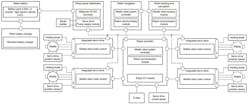Members can download this article in PDF format.
The rapid rate of technological advances across all segments of technology has created a plethora of new platforms. One emerging area is sensor fusion. This term reflects the integration of many different devices and technologies—advanced sensors; low-cost high-precision, microcontrollers (MCUs); and highly integrated servo motors and motor-control systems plus LiDAR, radar, optics, AI, algorithms, and more.
A subset of that integrates some of these elements, particularly advanced Hall-effect elements, MCUs, and motor-drive systems, ushering in the next generation of smart, autonomous mobile robots (AMRs).
These smart robots are becoming an integral part of many industries such as manufacturing, logistics, healthcare, transportation, hospitality, warehousing, medicine, delivery, life safety, the military, etc. With AMRs, the fusion of sensors, MCUs, and motor-control systems empowers a new level of performance by tightly integrating advanced Hall sensors, MCUs, and motor-control devices.
Hall Sensors
Let’s begin by introducing the Hall-effect sensor (or Hall sensor). In the late 1800s, Edwin Hall discovered the Hall effect, which is a method of converting m-fields to e-fields. Fundamentally, it’s simply a transducer that generates an output voltage proportional to the magnetic field applied perpendicularly to the element’s surface. A follow-on discussion of this function, with respect to AMR motor control, is provided later in this article.
The advantage of a Hall sensor is that it’s contactless and thus not subject to mechanical wear. It’s also impervious to noise, RF signals, air, and dust. These features make it ideal for applications such as electric motors, magnetic encoders, flow meters, proximity sensing, valves/solenoids, and tachometers, among many other applications.
The Hall sensor is particularly well-suited for AMR motors. A high-precision, multi-axis Hall-sensor design, such as the TI TMAG5170 high-precision, linear 3D Hall-effect sensor, is needed to deliver highly accurate, real-time data from the motors in the robot. Combined with a cutting-edge motor-drive system, such as the TI LAUNCHXL-F280025C coupled with the company’s BOOSTXL-DRV8323RS and its associated software development kit (SDK), the motor system becomes an intelligent multifunctional system for AMR motor control.
Sensor Fusion Drill-Down
The fusion between the Hall sensors, MCUs, and motor-drive systems is necessary for AMRs for two reasons. First, AMR motor functions in such robots need to be extremely precise. Second, the Hall sensors must be reliable, and more importantly, have tight performance specifications. Add a modern MCU to that mix and the fusion of these creates the perfect storm of performance and economics.
Many AMRs use three motor systems; therefore, the discussion will revolve around them. Such motors have a plethora of features that allow for flexible designs. Modern three-motor designs are more complicated than their earlier counterparts.
One enhancement is the quadrature encoder pulse (eQEP) block for decoding incoming pulse signals relating to position, speed, and direction. While this module has been around for nearly two decades, the latest iterations use advanced APIs and complex algorithms that broaden the application base of the module. This makes it possible for motors to have the much improved, (i.e., higher precision) specifications and performance required for today’s AMRs.
The MCU
Another critical component of sensor fusion is the MCU. Its main function is to transform a battery’s DC voltage into an AC voltage via a voltage source inverter (VSI). It takes the signal generated by the Hall sensor, or encoder, and converts it for use with vector control (or field-oriented control, FOC). This offers an excellent solution for maximizing torque efficiency, which is important for precise AMR control.
Other features of next-generation MCUs are significant for AMR control circuits, including soft-start and variable-frequency drives. On top of that, they have the ability to prevent electrical faults and overload, apply regenerative braking, and control (reverse) the direction of rotation to charge the DC source.
The Motor-Control System
Designing an AMR motor-drive system requires a highly scalable solution, such as the TI LAUNCHXL-F280025C along with the BOOSTXL-DRV8323RS. What makes it so elegant is the ability to simplify motor-control application design. It accomplishes this via the C2000Ware Motor Control SDK, which unifies the company’s TMS320F280049C and TMS320F280025C 32-bit MCUs.
An important benefit of this solution is real-time debug, which enables the designer to see the results of variable modifications as they’re applied. This is an extremely valuable feature in terms of saving time and, subsequently, cost. A typical three-phase motor-drive system is shown in the figure.
Modern Hall-Effect Sensors
Circling back to the Hall sensor, it has evolved into a much more complex device since its discovery. Today’s 3D positional Hall sensors measure linear, angular, and rotational magnetic fields (x, y, and z) from the sensors’ magnet orientation. They can also integrate an internal calculation engine and measurement averaging as well as gain and offset compensation when combined with a MCU that has sufficient processing power to act as an angle calculator.
Integrating a 3D Hall sensor device with an internal calculation engine will result in faster sample rates and lower latency, which are critical parameters for real-time motor control. Moreover, these sensors offer selectable magnetic sensitivity and temperature compensation options.
Couple that with new low-cost MCUs and such integration has the benefit of simplifying the software, reducing time to market and thereby lowering costs and improving safety. It also enables a slew of new AMR use cases.
Conclusion
Sensor fusion is an emerging platform that promises to open the door to a new world of advanced devices and applications. In this case, sensor fusion is the integration of 3D Hall elements, advanced low-cost and multi-featured MCUs, and next-generation motor-control solutions.
Going forward, expect sensor fusion to become a mainstream methodology that will create more use cases for AMRs. Also expect to see it find a home in a plethora of new and emerging Industry 4.0 applications.

